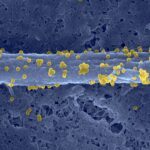Link to Pubmed [PMID] – 28192237
Link to HAL – pasteur-02185125
Link to DOI – 10.1016/j.cmi.2017.02.006
Clinical Microbiology and Infection, 2017, 23 (8), pp.574.e1-574.e6. ⟨10.1016/j.cmi.2017.02.006⟩
Objective: Infections are the major cause of morbidity and mortality in immunocompromised patients. Improving microbiological diagnosis in these patients is of paramount clinical importance. Methods: We performed this multicentre, blinded, prospective, proof-of-concept study, to compare untargeted next-generation sequencing with conventional microbiological methods for first-line diagnosis of infection in 101 immunocompromised adults. Patients were followed for 30 days and their blood samples, and in some cases nasopharyngeal swabs and/or biological fluids, were analysed. At the end of the study, expert clinicians evaluated the results of both methods. The primary outcome measure was the detection rate of clinically relevant viruses and bacteria at inclusion. Results: Clinically relevant viruses and bacteria identified by untargeted next-generation sequencing and conventional methods were concordant for 72 of 101 patients in samples taken at inclusion (k test ¼ 0.2, 95% CI 0.03-0.48). However, clinically relevant viruses and bacteria were detected in a significantly higher proportion of patients with untargeted next-generation sequencing than conventional methods at inclusion (36/101 (36%) vs. 11/101 (11%), respectively, p <0.001), and even when the latter were continued over 30 days (19/101 (19%), p 0.003). Untargeted next-generation sequencing had a high negative predictive value compared with conventional methods (64/65, 95% CI 0.95e1). Conclusions: Untargeted next-generation sequencing has a high negative predictive value and detects more clinically relevant viruses and bacteria than conventional microbiological methods. Untargeted next-generation sequencing is therefore a promising method for microbiological diagnosis in immu-nocompromised adults.





